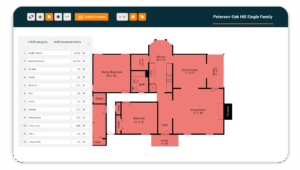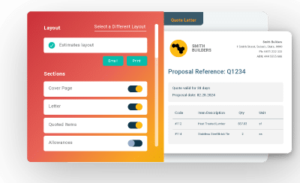What are the main stages of home construction projects?
Before diving into the details of how to better manage residential projects, let’s review the main stages of a construction project.
These include concept, design, preconstruction, procurement, construction and post-construction. Each one of these stages of construction is an equally important part of the entire project management plan.
1. Concept stage
Typically, as a home builder, or project manager, you will have started by consulting with planners, architects and engineers who have taken a homeowner’s idea to drawings and plans that ensure the overall design is proper for the proposed building site.
Depending on the size and scope of the project, this project planning phase may mean consultations with town or city planners to ensure utilities can serve the proposed location of the build.
You may also need to consult an estimator or do the project estimate yourself to determine if it’s financially viable for both you and the homeowner.
The concept stage is one of the most important phases in the lead up to actual construction. It gets rough ideas onto paper for the first time and forces home builders and homeowners to agree on initial budget targets. Too often, project management in the construction industry is not given enough attention.
Expect Early development challenges
A few common challenges pop up during this concept phase. These can include the following:
Design flaws — it’s important that you, any additional project managers, and your architect work together with your structural and civil engineers to create an architectural blueprint that’s realistic;
Bureaucracy — everyone hates bureaucracy, but it can be particularly frustrating when you’re in the preconstruction phase and needed paperwork must clear. While this isn’t necessarily your fault, it’s a common, frustrating problem that can inflate project costs if not given proper attention.
Poor-Defined Objectives—another common challenge is communicating requirements and limitations to your client and contractors – whether you’ve failed in this respect or members of your team have – not having clearly-defined goals that are documented can slow things down for the entire project.
2. Design Stage
The next planning stage is the design, where you build the actual project specifications. In this stage, you’ll hammer out your concepts and start talking in more detail with architects and engineers.
As one of the 6 stages of the construction project, your design phase will take on the challenge of getting monetary figures and drawings on how large the home will be, its shape and size, the number of rooms, how the rest of the space will be used, and so on.
This phase allows you to determine exactly how it will be done and even what materials you’ll use. The colors of various materials you’ll use (interior and exterior) and the pricing of those materials.
Common Challenges in design development
A few main challenges can crop up during the design stage. These include:
Inconsistencies in measurements across different types of blueprints. Your architect will need to make these measurements again to solve for discrepancies;
Over or Under-Estimation—you make money by providing accurate estimates using various tools. However, this estimate is just that – an estimate – and can be under or over based on factors outside of your control, like material price changes. More on this later;
Misreading of blueprints by other subcontractors who will do work based on those designs. Electricians and home builders sometimes misread each other’s design plans;
Structural design errors crop up due to misreading or misinterpreting (sometimes) vague building code language. Consult your planning phase team and the town or city building code department if this becomes a problem.
3. Preconstruction Stage
The preconstruction stage is where you’ll build your project team. The project team begins as the core group that will carry your project forward through the next construction process stages.
By this point, the building site will have been chosen and approved and your homeowner has approved your bid based on a detailed estimate.
Site & Foundation Preparation
One of the integral construction stages of building a house is the site visit, where the soil is tested – this is done to test for any contaminants that prevent successful well drilling, ensure ample room for a septic drain field if needed, or check that soils cannot possibly endanger the structural integrity of the home’s foundation.
Preconstruction is the last opportunity to check the site. Often, final tests are done after you pour test footings of the foundations. Once you’ve planned and framed your project’s foundation, plumbing and drainage will also be planned and installed during this process.
Rough Framing
Rough framing will also occur during this process based on your measurements. This means timbers will go up to rough measurements, and the house’s exterior shape will begin to take place. This is also true if you’re building an addition.
Common preconstruction Challenges
There are a few common challenges when conducting the preconstruction phase of any project. These can include:
Labor shortages—One of the hurdles facing almost every home construction company is labor shortages. This shortage means that site work, such as rough framing, may be delayed considerably if your contractor is experiencing issues due to this shortage. Be sure to consult with them before awarding them the contract;
Material shortages—Another huge challenge to the preconstruction phase of projects is material shortages. It’s important to plan far ahead when purchasing materials from your dealer to ensure the best price and timely delivery.
4. Procurement Stage
The procurement stage is also where construction companies can run afoul of the current construction industry climate. A variety of challenges include.
Lengthy procurement cycles—due to the uncertain market – at times high demand, low supply for certain materials – you may find that you’re quoted with weeks or months-long delays for specific materials.
Cost fluctuations—again, blame the market! You may discover that materials you were quoted a few months ago have now skyrocketed in price. This may force you to make different material choices depending on budget allowances. Don’t forget to communicate those changes to the homeowner in a timely fashion.
Quality assurance—while this is not necessarily your responsibility, one of the common challenges facing procurement departments is quality assurance.
5. Construction Stage
The construction stage is where the rubber meets the road. It’s where you’ll start to see your project come to life.
This phase is usually one of the longest construction phases of building a house. It takes months to come to fruition. It’s also the most rewarding part of the construction process stages.
Common Challenges
When it comes to the final stages of your construction project, you’re bound to encounter some unforeseen issues. Here are some common challenges during the construction stages of building a house.
Health And Safety—this is one of the biggest of any construction company owner out there. The health and safety of your employees are always your top priority. In the construction phase, an accident can occur, which can severely injure one of your valuable team members and cause huge delays in the project;
Linear Process Delays—the construction phase of any project is the longest one. It is also a linear process, meaning that schedules must be planned and executed in the proper order;
The Weather—everyone who works in construction hates that they’re at the mercy of Mother Nature. Certain construction phases won’t proceed in heavy rain or blinding heat.
6. Post-construction Stage
The post-construction stage is the final stage of the construction phase plan. The post-construction phase is where the build is completed and the new owner eventually takes possession. However, there are several steps to go through:
Performance And Monitoring
One of the key parts of this stage is monitoring the building once it’s finished for any signs of faults – this may require days or weeks. Meanwhile, other things can happen behind the scenes, such as contract closures, worker payments and equipment returns.
Team meetings can occur to discuss what went well with the project and what didn’t, and what changes can be made on the next project to help things run smoother – time is money, after all.
Closure
Closing the project means delivering the keys for the new construction to the new owner, closing and sealing all contracts, and getting paid for the work completed.
Common Challenges
Despite being the end of the line, closure brings challenges. These can include:
- Projects wind up over-budget;
- Customers are unhappy with the finished product;
- Projects vastly underperform projected profit margins;
- The project reveals gaping holes in business operations.
Upgrade your project management with Buildxact
With many different types of project management and estimating software options for small builders on the market, it isn’t easy to know which one is the ideal fit for your construction management business. Some of them only do estimating, while others are simply for scheduling work. On top of that, most of them are way too hard to use!
Fortunately, Buildxact has created construction management software that’s for the entire project life cycle. It’s an easy to use package, with a many useful features to help you seamlessly do takeoffs, estimates and manage your construction project management process all in one place.
Read on to learn more about Buildxact’s features, get started with a free trial, or speak with our customer support team to ask a question.
Access project progresses from anywhere via the cloud
You can access Buildxact’s construction estimating software with nothing more than an internet connection and a browser. You can log in to manage your project progress and get things done wherever you have internet access, from your laptop, tablet, or even your phone. If you are a small builder or trade who’s on the road or regularly need to travel between job sites, you’ll be far more productive when you can work the entire construction process from wherever you are.
Because Buildxact’s construction estimating software is cloud-based, it can also easily sync project costs with your accounting software.
Cloud access also means that we deal with the technology side of things; so you don’t need to worry about servers or installing and maintaining any software on your computer or laptop. Simply log on and get started.
Faster, easier takeoffs
Using a construction project management tool like Buildxact can save many hours, completing takeoffs up to 80 percent faster, using the online takeoff tool. Upload your PDF plans, and with a few clicks, you can measure and price your jobs, with takeoffs automatically producing your bill of quantities, while streamlining the information straight to your quote letter.
We now move to the next part of Buildxact.
More accurate job costs
To create accurate estimates in no time, Buildxact lets you load contract, and dealer pricing lists directly from spreadsheets. Estimates can be created with automatic wastage and rounding features and composite assemblies to help streamline job costs faster.
Automatic scheduling
Buildxact helps manage your project schedule by automatically generating them from your estimates. It means you can stay on top while tracking a job’s progress, set a critical path, so when pushbacks occur, the schedule is adjusted automatically.
Another key part of this feature is that it helps you save time by keeping your project team in the loop by sending automated SMS and email reminders. It saves the hassle of constantly being on the phone to remind them when they should be on the construction site.
Professional quotes and invoicing
There’s nothing more unprofessional or off-putting than an ugly quote or invoice. With Buildxact, you can automatically turn your job estimates into quotes and invoices that look good and impress your customers. You can include branding like logos, detailed specifications, and breakdowns of your listed allowance or provisional items.
Easier budgeting
You’ll be pleased to know that Buildxact’s construction estimate software streamlines all cost tracking and purchasing by easily comparing your job estimate to actual spending, so you’ll always know if you’re under or over budget on a job.
It takes a short amount of time to produce purchase orders, and you can check anytime whether you are under or over budget, thanks to the actuals vs. estimates report.
Integration with other software
The future is all about connectivity between platforms. Buildxact integrates project data with accounting software and other apps, including:
- Xero
- Deputy
- Quickbooks
No double handling – all the information is stored in Buildxact and flows straight into your accounting software of choice, ready for payment.
Another integration example is Deputy integration. Your team members hours are synced up and allocated against job budgets to keep everything in order. It will automatically streamline this information into your accounting system for weekly or monthly payroll.
Got questions? Find out more
Buildxact is more than just a construction estimating tool for builders – it offers features that help you streamline the entire job management process from start to finish.
If you’re unsure whether it’s the right fit for your business, get in touch with our team, who will be happy to answer any questions you have in a one on one, online demo. Alternatively, you can start a free 14-day trial right away.


















